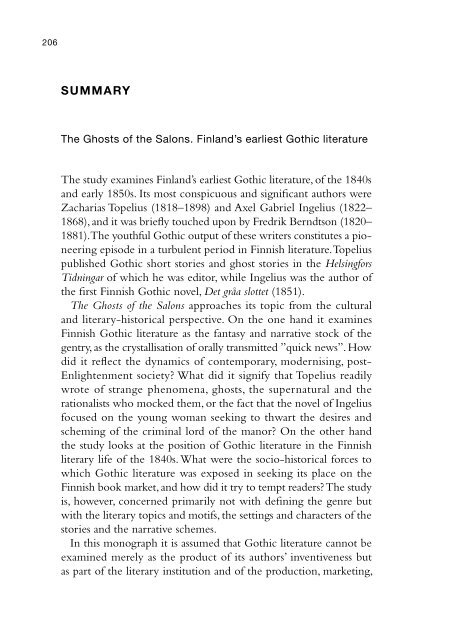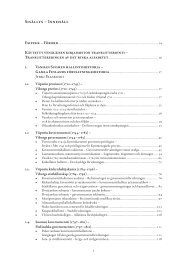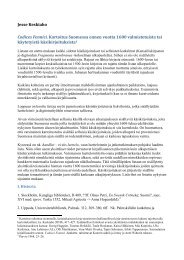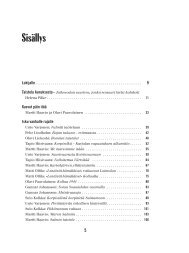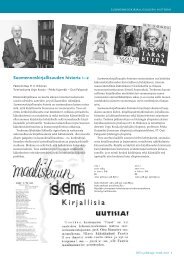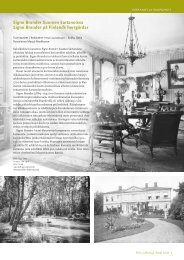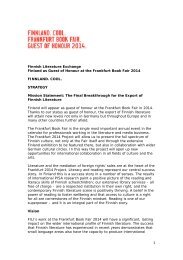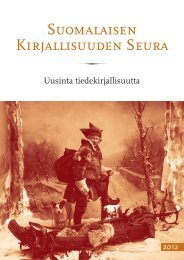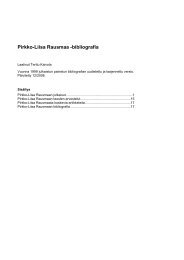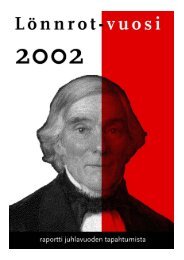SUMMARY The study examines Finland's earliest Gothic literature ...
SUMMARY The study examines Finland's earliest Gothic literature ...
SUMMARY The study examines Finland's earliest Gothic literature ...
Create successful ePaper yourself
Turn your PDF publications into a flip-book with our unique Google optimized e-Paper software.
206 SALONKIEN AAVEET<strong>SUMMARY</strong><strong>The</strong> Ghosts of the Salons. Finland’s <strong>earliest</strong> <strong>Gothic</strong> <strong>literature</strong><strong>The</strong> <strong>study</strong> <strong>examines</strong> Finland’s <strong>earliest</strong> <strong>Gothic</strong> <strong>literature</strong>, of the 1840sand early 1850s. Its most conspicuous and significant authors wereZacharias Topelius (1818–1898) and Axel Gabriel Ingelius (1822–1868), and it was briefly touched upon by Fredrik Berndtson (1820–1881). <strong>The</strong> youthful <strong>Gothic</strong> output of these writers constitutes a pioneeringepisode in a turbulent period in Finnish <strong>literature</strong>. Topeliuspublished <strong>Gothic</strong> short stories and ghost stories in the HelsingforsTidningar of which he was editor, while Ingelius was the author ofthe first Finnish <strong>Gothic</strong> novel, Det gråa slottet (1851).<strong>The</strong> Ghosts of the Salons approaches its topic from the culturaland literary-historical perspective. On the one hand it <strong>examines</strong>Finnish <strong>Gothic</strong> <strong>literature</strong> as the fantasy and narrative stock of thegentry, as the crystallisation of orally transmitted ”quick news”. Howdid it reflect the dynamics of contemporary, modernising, post-Enlightenment society? What did it signify that Topelius readilywrote of strange phenomena, ghosts, the supernatural and therationalists who mocked them, or the fact that the novel of Ingeliusfocused on the young woman seeking to thwart the desires andscheming of the criminal lord of the manor? On the other handthe <strong>study</strong> looks at the position of <strong>Gothic</strong> <strong>literature</strong> in the Finnishliterary life of the 1840s. What were the socio-historical forces towhich <strong>Gothic</strong> <strong>literature</strong> was exposed in seeking its place on theFinnish book market, and how did it try to tempt readers? <strong>The</strong> <strong>study</strong>is, however, concerned primarily not with defining the genre butwith the literary topics and motifs, the settings and characters of thestories and the narrative schemes.In this monograph it is assumed that <strong>Gothic</strong> <strong>literature</strong> cannot beexamined merely as the product of its authors’ inventiveness butas part of the literary institution and of the production, marketing,
ENGLISH <strong>SUMMARY</strong> 209editor of Kanawa, disparaged the spiritual and ideological povertyof the short stories by Topelius and Berndtson. Instead of meregenre paintings he appealed for topics of major national and socialsignificance.<strong>The</strong> <strong>earliest</strong> <strong>Gothic</strong> <strong>literature</strong> in Finland did nevertheless take astand on major contemporary issues. Topelius’s concept of the spiritworld was deeply rooted in the tensions between the Enlightenmentand Romanticism. It reflected the post-Enlightenment experiencethat despite the progress made in the fields of knowledge and moralitythere was in reality something still unattainable. His reflections inthe story Månskenet på klippan (1844) on the interweaving of sensoryand supersensory reality made his <strong>Gothic</strong> output part of the debateon human cognizance and its limitations. <strong>The</strong> view of supernaturalbeings as forces guiding human action and not as mere objects tobe observed further dissociated Topelius’s thinking from the moraltheory of Kant. It was natural for Topelius to write short stories inthe manner of folk tales about punishments wrought by alien forcesor the souls of the dead returning to the land of the living. Suchtales as Askonsdagsbruden (1843), Den gamle beckbrännaren (1845) orToholampi (1850) mirrored the conviction that there existed in theworld a moral balance reminiscent of the inevitability of nature thatrectified any wrongs.Though of a completely different nature, yet springing just asmuch from the social and intellectual trend at the time, were theviews portrayed in Ingelius’s <strong>Gothic</strong> novel of the supernatural andthe potential open to man. In describing a nobleman’s decline and apatriarchy maintained by harsh means, Det gråa slottet destroyed themagic, spoke of ghosts in jest and replaced the supernatural helpersand avengers with people’s own determination. <strong>The</strong> author furtherseasoned the set-up with melodrama and romantic reverie. <strong>The</strong> resultwas a gripping story about the way in which the order and powerrelations in the community changed when the young generationrefused to accept the injustices resorted to by a social class that hadoutlived its times in seeking to uphold its hereditary status.Injustices abounded in early Finnish <strong>Gothic</strong> <strong>literature</strong>. In his short
210 SALONKIEN AAVEETstory En svart saga (1846) Berndtson, like Ingelius, described anunscrupulousness that did not stop at selfishness and murder. Topeliuspainted a picture of the harm caused by a bad and biased educationin the story En natt och en morgon (1843) and the fate of an individualin a house of confinement in the short story Bruden (1846). As incontemporary novels, all this entertained the Finnish reader andelicited the concern of the critics warning of the damaging effectsof this thirst for reading matter.Early Finnish <strong>Gothic</strong> <strong>literature</strong> did not, however, incorporateany socially or politically radical elements, and nor can it be saidto have been morally very harmful. Melodrama was a genre usedin nineteenth-century horror <strong>literature</strong> and favoured by Finnishwriters, too, its aim being to reveal a world that is good and just.What is more, the horror stories inspired by envy, hate, ruthlessness,selfishness, loss of all sense of reality, lust for revenge and otheremotions considered unfitting to the self-control and Christianvalues upheld by the bourgeoisie offered their readers a vicariouschance to experience them. This aspect of <strong>Gothic</strong> <strong>literature</strong> restoredthe reader’s emotional equilibrium, which in turn promoted ratherthan sullied his/her moral welfare.


